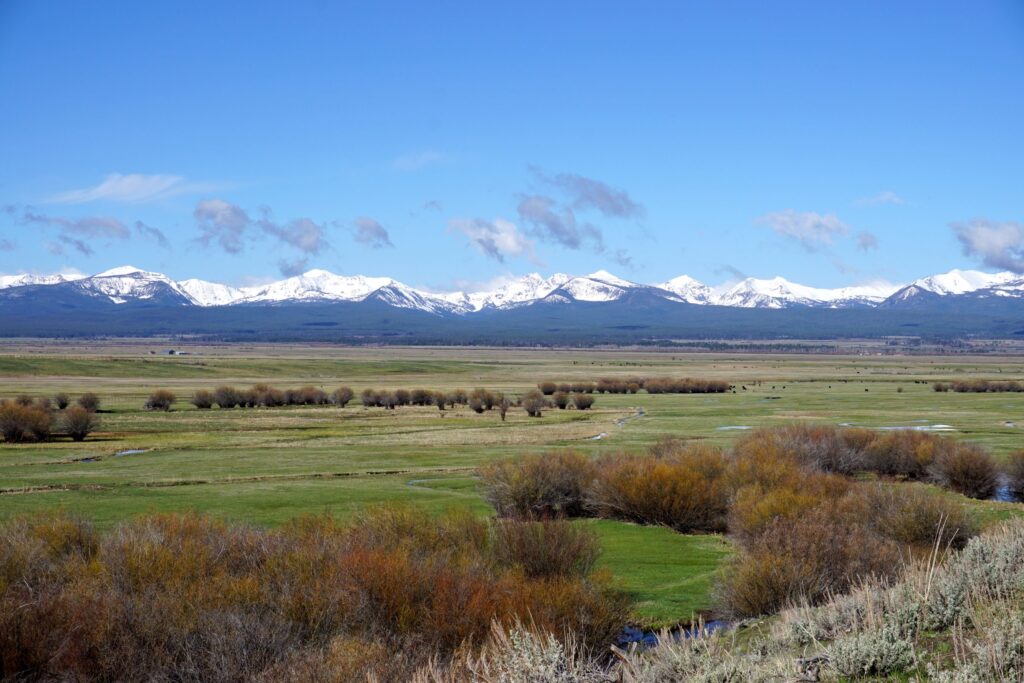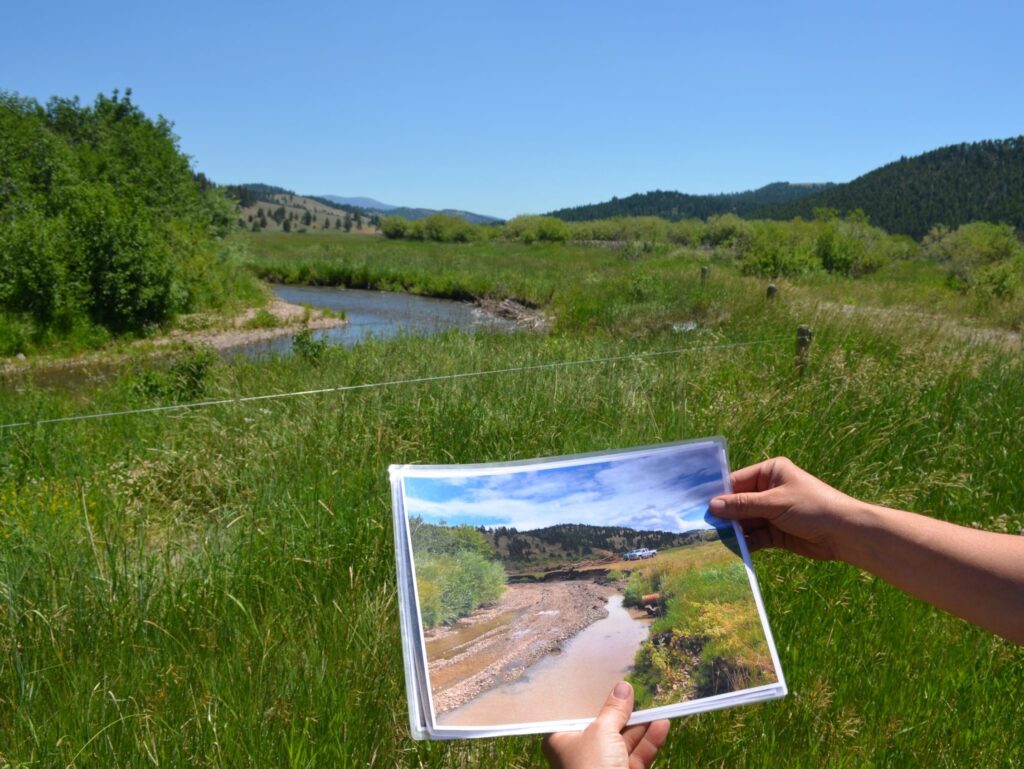Decades of restoration are accumulating to keep a key tributary to Montana’s Blackfoot River functioning for ranchers and native trout.
On a late August morning, Ryen Neudecker and Brent Mannix watch water drip out of a seep above a lazy section of Nevada Creek. The creek’s waters are languid as it runs underneath a thick canopy of alder and willow—flows are always low this time of year—and the trickle of water provides a pleasant backdrop for Neudecker and Mannix’s conversation.
It would be more pleasant if the water from the seep weren’t coming from the Douglas Canal, which just so happens to be the main source of irrigation water for the ranchers along Nevada Creek. Here, the canal is sandwiched between a county road and, more recently, the creek. Over the last few years, Nevada Creek has pushed closer and closer to the base of the canal, threatening to erode into the 20-foot slope of earth keeping the canal’s water traveling on its path to the 6,000 acres of irrigated hay meadows of Montana’s Helmville Valley.
Peering up at the top of the bank separating the canal from the creek, Mannix, the president of the Nevada Creek Water Users Association, points out why he’s not the only rancher who is losing sleep over this stretch of water.
“If you go to crawl down [from the top of the canal bank], you’d mostly just fall down and hope you catch yourself before you hit the creek,” he said. “It’s really steep. I can’t believe it’s lasted this long.”
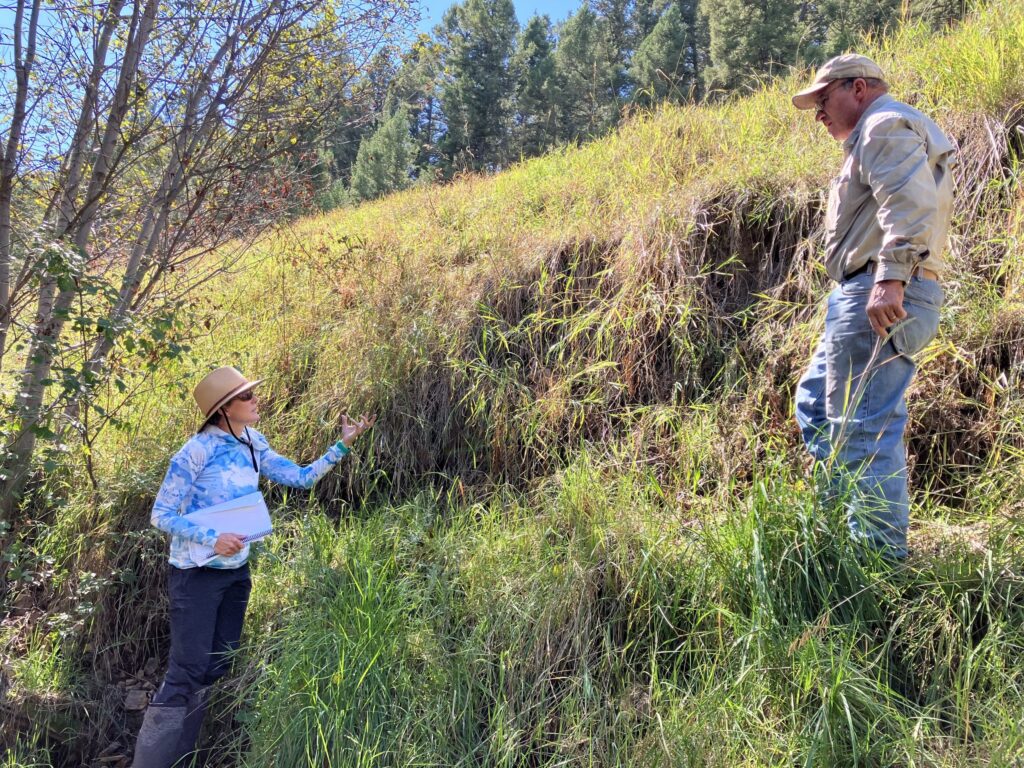
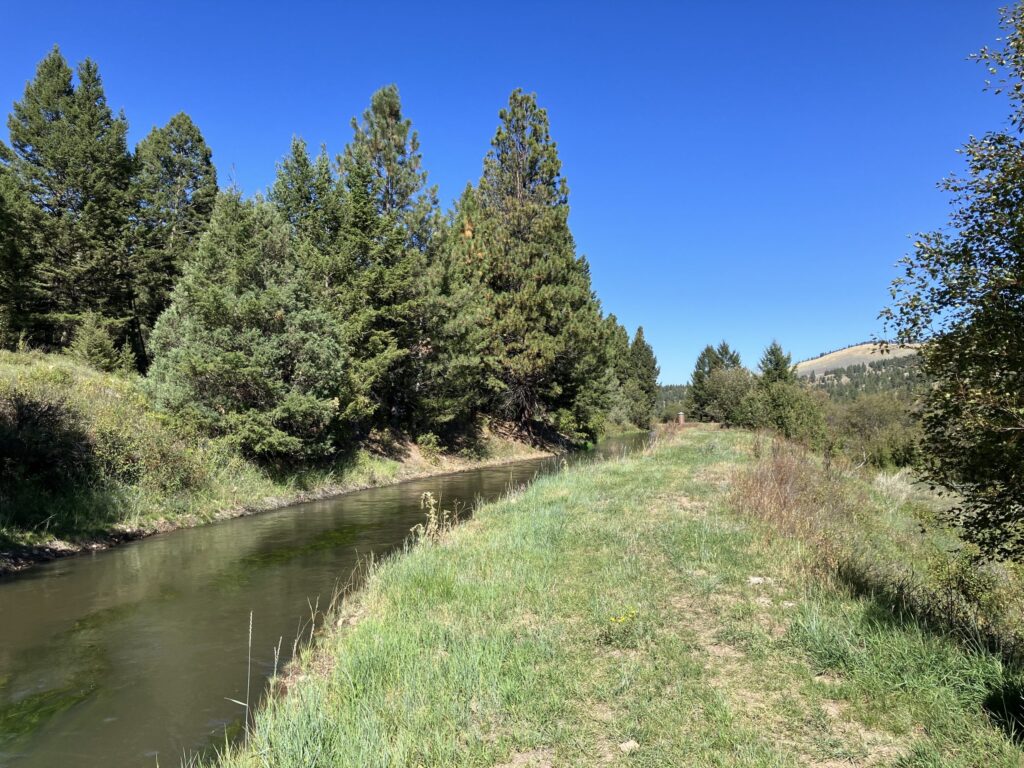
Left: Neudecker and Brent Mannix of the Nevada Creek Water Users Association examine the bank that forms the barrier between Nevada Creek and the Douglas Canal. As the creek has eroded into this bank over the years, the hillside has steepened and sluffed away, thinning the barrier of earth that keeps the Helmville Valley’s irrigation water flowing. Right: The Douglas Canal is the major source of irrigation water to agriculture in the Helmville Valley.
The creek’s creep up on the canal happened slowly at first, but now is becoming a major concern for the Nevada Creek Water Users Association, which noticed the growing issue in late 2021.
“I just look at this and see a major wreck coming,” Mannix said. “If this washed out, it would really hurt all the people who own land because they couldn’t irrigate it, it would put a whole lot of sediment in the creek. And to put the canal back, if the creek were still here, seems almost impossible.”
That’s why Neudecker and Mannix are standing here talking in the shrubby shade of a hot August day. Neudecker, the project coordinator for the Big Blackfoot Chapter of Trout Unlimited (BBCTU), is here to check in on a stream and riparian restoration project on this section of Nevada Creek. The project will both protect the Douglas Canal and continue work that Neudecker and a suite of partners have done over the years to restore Nevada Creek as tributary habitat for native trout, including endangered bull trout.
“With this project, we can protect the canal, we can restore Nevada Creek, and we can bring the stream flows back up and restore the floodplain,” Neudecker said. “You don’t even have to care about fish to be supportive of this work.”
The ranchers have much to lose to a degraded waterway. For decades, ranching families that live on Nevada Creek’s banks were used to trying to keep water from stealing feet of stream banks and sometimes acres of pasture they depend on for grazing and haying. One rancher lost seven acres of pasture in seven years to the creek’s seasonal floodwaters.
Not unexpectedly, sediment loads in the creek were notoriously high—all that pasture washing downstream into the cold, clear waters of Montana’s famed Blackfoot River. And that presents a problem for trout.
“Nevada Creek is the second-largest tributary to the Blackfoot and has a huge influence on the river,” said Patrick Uthe, a fisheries biologist for Montana Fish, Wildlife, and Parks (FWP). “[The stretch of river] from the confluence of Nevada Creek to the confluence of the North Fork of the Blackfoot has long been documented as having the lowest trout densities due to water quality issues, sedimentation, and degraded tributaries.”
The blue-ribbon trout fishery provided by the waters of the Blackfoot and its tributaries has been subject to three decades of restoration. Until just over a decade ago, however, Nevada Creek was overlooked for this restoration work, despite its potential to provide critical spawning and overwintering habitat for native cutthroat and endangered bull trout. But in 2009, BBCTU began working with FWP, the U.S. Fish and Wildlife Service Partners for Fish and Wildlife Program, Montana Department of Environmental Quality, Wildland Hydrology, and the Blackfoot Challenge to do a couple of instream and riparian restoration projects on private land owned by local ranchers Wade and Diana Stitt. In 2011, there was a major flooding event that put the entire project site underwater for over 100 days. When the waters receded, the restoration had, for the most part, held up well.
IWJV science shows that flood-irrigated wet meadows like the ones along Nevada Creek provide important stopover habitat for Greater sandhill cranes. Restoration work that keeps these wet meadows intact and seasonally flooded is crucial to keeping these stopover sites productive for cranes and other wildlife.
“Those initial projects really got the ball rolling,” Uthe said. “The fisheries monitoring showed that the creek was responding and underscored that this was a worthwhile place to work on habitat.”
The project restoring the section of stream threatening the Douglas Canal will be the sixth phase of riparian restoration work on Nevada Creek completed when work wraps up in late 2023. This phase will put the creek back into its historic channel, which would provide a 400-foot buffer between the creek and the canal. It will also create swales—depressions in the floodplain—for water to collect and slowly percolate back into the floodplain; essentially, it will mimic what nature does in a healthy, functioning riparian corridor.
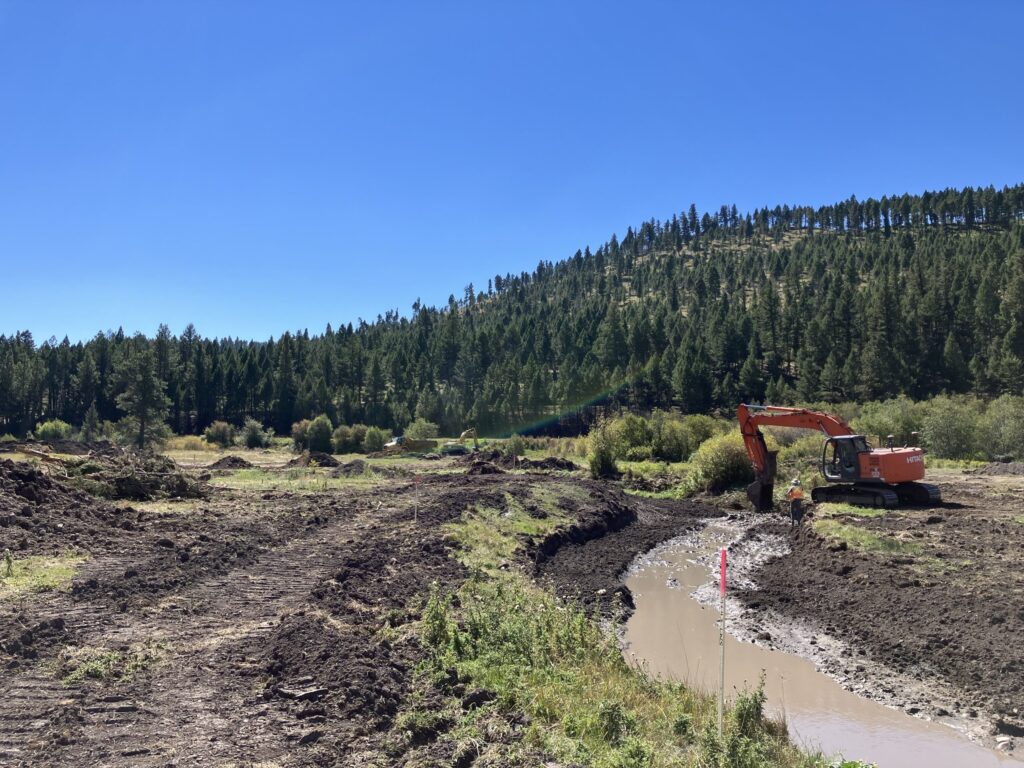
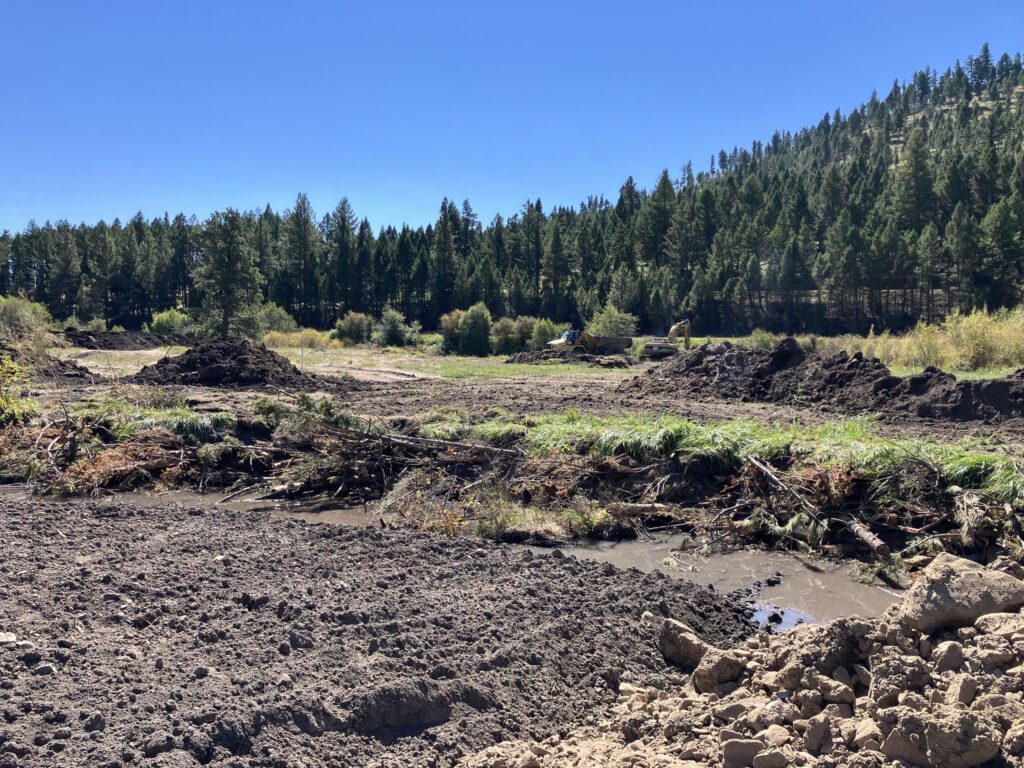
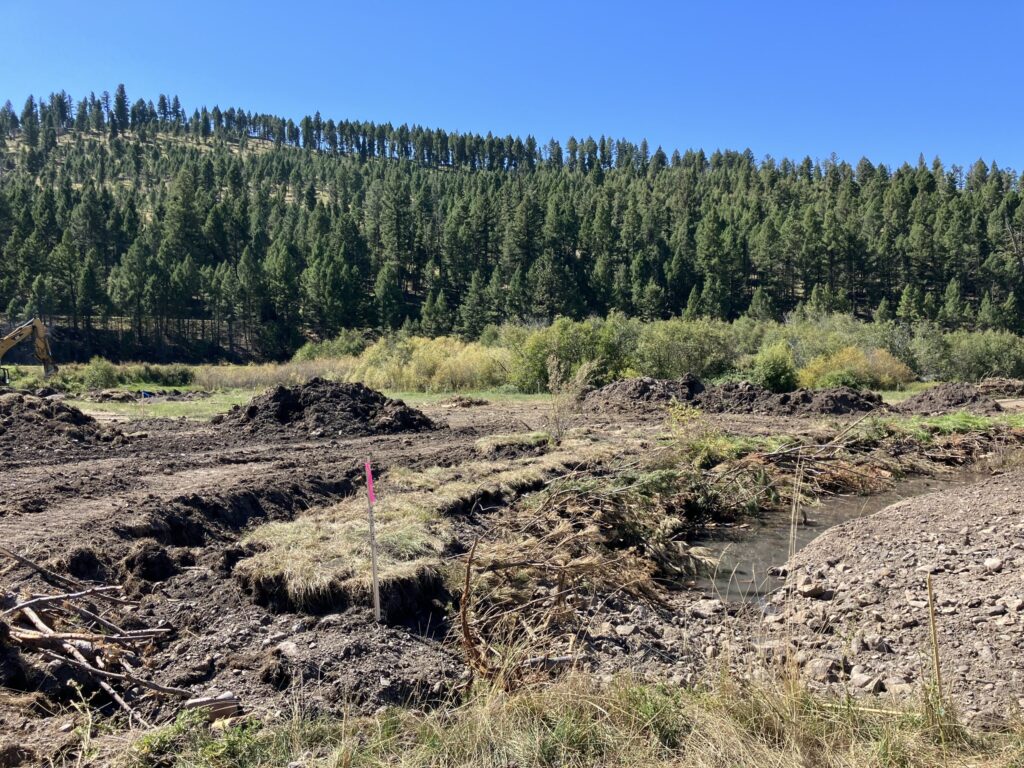
The restoration work on this stretch of Nevada Creek will move water back into a historical channel and away from Douglas Canal. Features like oxbows and swales will help reduce erosion, spread out sediment from high-water events, and retain groundwater in the floodplain. Woody debris from local timber projects will help shore up the banks and provide shade for trout until riparian vegetation like willows are able to regrow (BBCTU hosts willow planting days for volunteers for its Nevada Creek projects).
Neudecker pointed out that this phase of the project, like the ones before it, would not be possible without the landowner’s interest in restoring the creek. Aside from the first projects below the dam, all of this work has taken place on private land adjacent to a state highway. As a result, the work on Nevada Creek is highly visible to the tight-knit community, Neudecker said.
“That’s one of the things about Nevada Creek—the fact that people can see it makes them more comfortable doing the work,” she said. “It’s not some obscure place. It’s something you can see in real time and say, it does look different, it looks better.”
So, when members of the Nevada Creek Water Users Association noticed the canal being threatened, they knew where to turn for help. They knew what had already been accomplished along Nevada Creek in the other phases of riparian restoration—these projects happened on their family, friends, and neighbors’ land. The community had seen these projects hold up well in high-water events, seen the grass grow green and healthy and support grazing and haying, and seen the streambanks stop crumbling into the water each year.
They’d also seen the collaboration among the group of partners do something else extraordinary: get work done in a regulatory system that can present hurdles in the form of paperwork and permitting. Neudecker said that permitting is a major challenge of riparian and stream restoration projects and it is only getting more complicated.

Neudecker, left, works with landowner Jamie Stitt on another phase of Nevada Creek restoration work in 2021. USFWS Partners for Fish and Wildlife Program biologist Becca Reeves said that Neudecker herself is the secret to the partnership’s success. “Ryen is essential,” Reeves said. “With a different person, I don’t know that these projects would make it across the finish line.”
However, having a group of agencies and organizations working on a project can streamline the work. Becca Reeves, the Partners for Fish and Wildlife Program biologist based in Ovando, said that her understanding of the permitting system and regulatory structures like the Endangered Species Act means that she is able to tackle a lot of the permitting for the partnership’s projects.
“I try to be an umbrella to shield people from paperwork,” she said.
In turn, Reeves said it helps her to be able to work with renowned fisheries experts like Uthe and FWP, which can make regulators more open to the project and willing to work around red tape.
And that’s just the regulatory end of a project—then there are the bids and fundraising and contracting and the project design itself. When each partner contributes what they can, the work gets done more efficiently, Neudecker said.
“It’s just all these things along the way that the partners can bring in,” Neudecker said. “When everyone can pull their money and their skills, it helps everyone meet their targets and get their jobs done.”
And when jobs get done, the support for restoration work grows, among local landowners and contributing agencies alike. Healthy creeks and stable infrastructure keep this community’s economic and ecological functions strong. The momentum this partnership has built in the Blackfoot watershed means that both of these goals can be met, making the future bright for both fish and people.
Phase 6 of Nevada Creek restoration work was made possible by landowners EBK Investments, John and Jamie Stitt, Jessop Lodge, USFWS Partners Program & Bull Trout Recovery Challenge, Nevada Creek Water Users Association, MT FWP Future Fisheries, MT DEQ 319 Program, River Design Group, Glacier Excavating, Big Blackfoot Chapter of Trout Unlimited Private donors, United States Forest Service, Blackfoot Challenge, Westslope Chapter Trout Unlimited, Western Native Trout Initiative (WNTI), as well as local schools, and volunteers.

